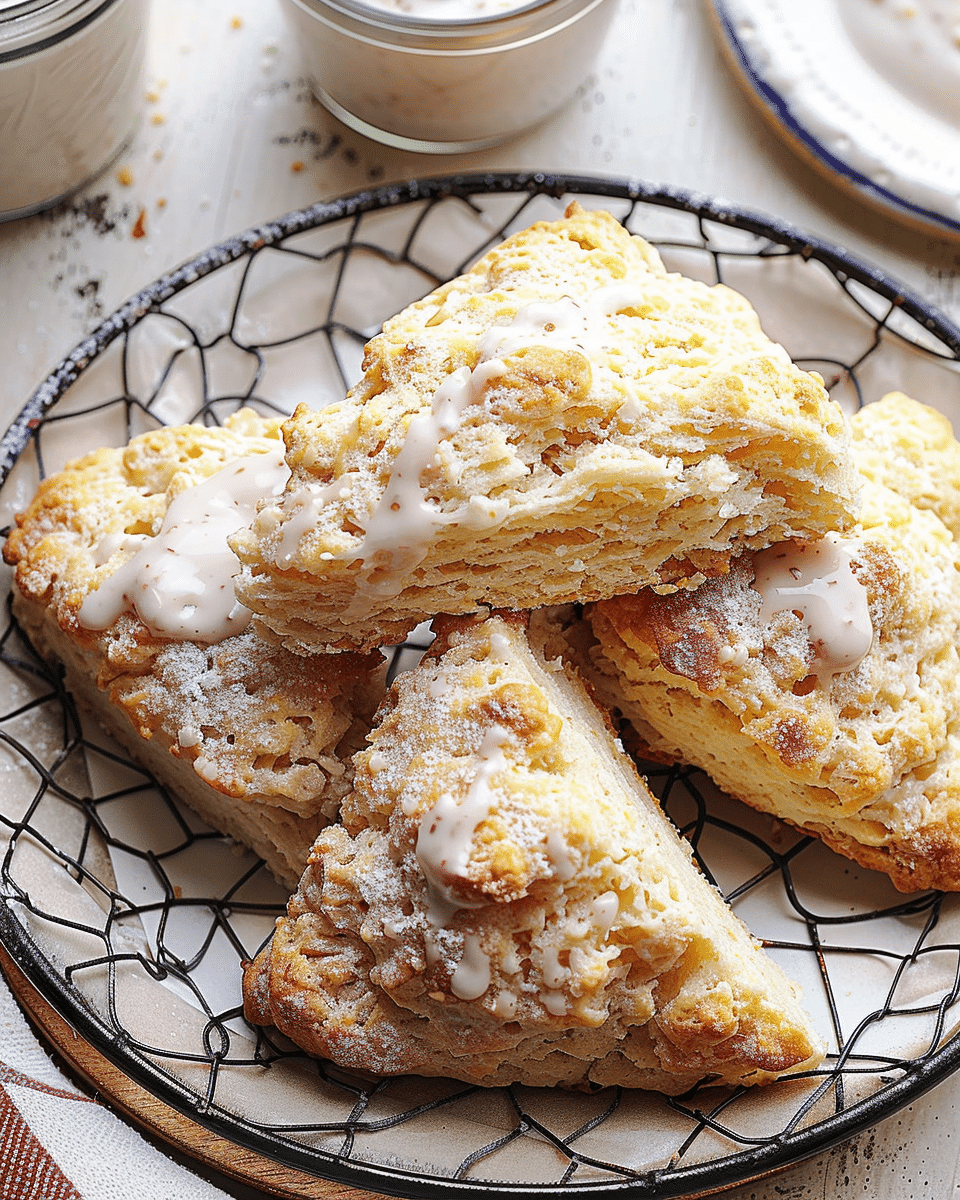Why You’ll Love This Recipe
These scones are everything you want in a classic treat: ultra-buttery, slightly sweet, and wonderfully flaky. They come together quickly (just 35 minutes!) and are perfect for breakfast, tea time, or even as a light dessert. Plus, the versatility of this recipe means you can easily customize your scones by adding dried fruit, chocolate, or nuts. You’ll be left with a perfect, melt-in-your-mouth scone every time!
Ingredients
(Tip: You’ll find the full list of ingredients and measurements in the recipe card below.)
- 3 cups (381 grams) all-purpose flour, measured correctly
- 1/3 cup (66 grams) granulated sugar
- 1 teaspoon fine sea salt
- 1 tablespoon baking powder
- 1/2 teaspoon baking soda
- 1 1/2 sticks (170 grams) unsalted butter, cold and cubed
- 1 cup (237 grams) buttermilk
- 2 large eggs, divided
- 1 teaspoon vanilla extract
- Coarse sugar, for topping
Directions
- Preheat the Oven: Adjust the oven rack to the center position and preheat the oven to 400°F (200°C). Line two baking pans with parchment paper.
- Prepare the Dry Ingredients: In a large bowl, combine the flour, sugar, salt, baking powder, and baking soda.
- Cut in the Butter: Add the cold cubed butter to the flour mixture and use a pastry cutter or fork to cut the butter into the flour until the mixture resembles large peas.
- Mix Wet Ingredients: In a separate bowl, whisk together the buttermilk, 1 egg, and vanilla extract.
- Combine the Wet and Dry: Make a well in the center of the dry ingredients and pour in the wet ingredients. Mix gently with a spoon or spatula until just combined—be careful not to overmix. If you’re adding any dried fruit, nuts, or chocolate chips, do so now.
- Form the Dough: Transfer the dough to a floured surface. For extra flaky scones, see the “Optional Step” in the recipe notes for lamination instructions. Otherwise, divide the dough into two equal parts.
- Shape the Scones: Lightly knead each dough portion into a 3/4-inch thick, 6-inch diameter round. Cut each round into 8 wedges and place them on the prepared baking pans, spacing them about 2 inches apart.
- Make-Ahead Instructions: If you prefer to bake later, you can refrigerate the unbaked scones overnight or freeze them in an airtight container for up to 1 month. If baking from frozen, add about 2 extra minutes to the baking time.
- Finish and Bake: In a small bowl, combine the remaining egg with 1 teaspoon of water, then brush this egg wash over the scones. Sprinkle coarse sugar on top. Bake the scones for 12 to 15 minutes, or until lightly browned on top. They’re best served warm or within a few hours of baking.
Servings and Timing
- Yield: 16 scones
- Prep Time: 20 minutes
- Cook Time: 15 minutes
- Total Time: 35 minutes
Variations
- Add-Ins: Fold in dried fruit like raisins, currants, or cranberries, or add chocolate chips, chopped nuts, or even a bit of lemon zest to give your scones a personal twist.
- Lemon Glaze: After baking, drizzle a simple lemon glaze (powdered sugar mixed with lemon juice) on top for an extra burst of flavor.
- Sweet and Savory: For a savory version, add shredded cheese (like cheddar) and chopped herbs (like rosemary or thyme) for a perfect pairing with soups or salads.
- Mini Scones: For smaller, bite-sized scones, divide the dough into 16 smaller rounds and reduce baking time by a couple of minutes.
Storage/Reheating
Scones are best served fresh but can be stored in an airtight container at room temperature for 2-3 days. If you want to keep them longer, refrigerate or freeze them. Reheat scones in the oven at 300°F (150°C) for 5–10 minutes for a fresh-from-the-oven experience.
FAQs
1. Can I use regular milk instead of buttermilk?
While buttermilk gives scones their signature texture and tang, you can substitute it with regular milk mixed with 1 tablespoon of lemon juice or vinegar to mimic the acidity.
2. How do I avoid tough scones?
Be sure to not overmix the dough. Mix only until the ingredients are combined. The less you handle the dough, the more tender your scones will be.
3. Can I freeze the dough before baking?
Yes, you can freeze the unbaked scones. Place them on a baking sheet and freeze until firm, then transfer them to a freezer bag or airtight container for up to a month. When ready to bake, add 2 extra minutes to the baking time.
4. What can I use instead of coarse sugar?
If you don’t have coarse sugar, you can use regular granulated sugar, but the crunch and sparkle may not be as pronounced.
5. Can I make these scones gluten-free?
Yes, substitute the all-purpose flour with a 1:1 gluten-free flour blend, and be sure to check that your baking powder and soda are gluten-free.
6. How do I know when the scones are done?
The scones should be lightly golden brown on top and firm to the touch. You can also insert a toothpick into the center; if it comes out clean, they’re done.
7. How do I make my scones taller and flakier?
Follow the optional lamination step in the recipe notes to create flaky layers in the dough. This folding technique helps achieve taller scones with a more delicate texture.
8. Can I make the scones sweeter?
If you prefer sweeter scones, simply add an extra tablespoon of sugar to the dough or top the scones with a glaze after baking.
9. What’s the best way to serve scones?
Scones are delicious on their own, but they’re even better when served with clotted cream, jam, or honey. For a more decadent treat, add a drizzle of chocolate sauce or lemon glaze.
10. Can I use a food processor to make the dough?
Yes, you can use a food processor to cut in the butter, but be sure not to overwork the dough. Pulse the mixture until the butter is in small pea-sized pieces, and then proceed with mixing in the wet ingredients.
Conclusion
These classic scones are the epitome of comfort baking—fluffy, buttery, and incredibly easy to make. Whether you enjoy them plain, with jam, or as a base for other fillings, they’re sure to be a hit. With a few simple ingredients and helpful tips, you’ll be able to make scones that rival any coffee shop’s, and they’ll be on your table in just 35 minutes!
Classic Scones Recipe
These classic scones are buttery, flaky, and perfect for any occasion. They come together quickly and are great for breakfast, tea time, or as a light dessert. Customize with your favorite add-ins for a personal twist!
- Prep Time: 20 minutes
- Cook Time: 15 minutes
- Total Time: 35 minutes
- Yield: 16 scones
- Category: Baking
- Method: Baking
- Cuisine: British
- Diet: Vegetarian
Ingredients
3 cups (381 grams) all-purpose flour, measured correctly
1/3 cup (66 grams) granulated sugar
1 teaspoon fine sea salt
1 tablespoon baking powder
1/2 teaspoon baking soda
1 1/2 sticks (170 grams) unsalted butter, cold and cubed
1 cup (237 grams) buttermilk
2 large eggs, divided
1 teaspoon vanilla extract
Coarse sugar, for topping
Instructions
- Preheat the oven to 400°F (200°C). Line two baking pans with parchment paper.
- In a large bowl, combine flour, sugar, salt, baking powder, and baking soda.
- Add the cold cubed butter and use a pastry cutter or fork to cut the butter into the flour until it resembles large peas.
- In a separate bowl, whisk together buttermilk, 1 egg, and vanilla extract.
- Make a well in the center of the dry ingredients and pour in the wet ingredients. Mix gently until just combined. Be careful not to overmix. Add any optional add-ins (dried fruit, chocolate chips, nuts) now.
- Transfer the dough to a floured surface. For extra flaky scones, see the optional lamination step for folding. Otherwise, divide the dough into two equal parts.
- Lightly knead each portion into a 3/4-inch thick, 6-inch round. Cut each round into 8 wedges and place them on the prepared pans, spacing them about 2 inches apart.
- If making ahead, refrigerate unbaked scones overnight or freeze for up to 1 month. When baking from frozen, add 2 extra minutes to the time.
- In a small bowl, combine the remaining egg with 1 teaspoon of water and brush it over the scones. Sprinkle with coarse sugar. Bake for 12–15 minutes, or until lightly golden on top. Serve warm or within a few hours of baking.
Notes
For extra flaky scones, follow the optional lamination instructions for folding the dough.
Try adding raisins, currants, cranberries, or chocolate chips for a different flavor twist.
For a savory version, try adding shredded cheese and fresh herbs like rosemary or thyme.
If you want sweeter scones, add an extra tablespoon of sugar to the dough or top with a glaze after baking.
Nutrition
- Serving Size: 1 scone
- Calories: 220
- Sugar: 8g
- Sodium: 180mg
- Fat: 10g
- Saturated Fat: 6g
- Unsaturated Fat: 3g
- Trans Fat: 0g
- Carbohydrates: 30g
- Fiber: 1g
- Protein: 3g
- Cholesterol: 35mg



